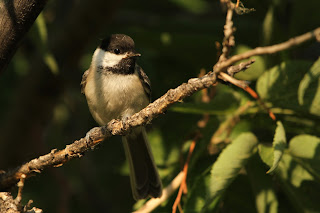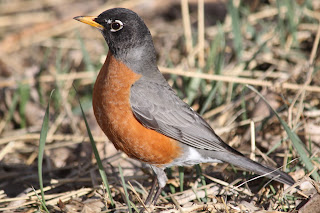Class #2 comes just two days after the first field
trip. Yeah, that one: the one that left me feeling so rotten. Those two days have been full of lots of
soul-searching (is this really the thing for me at this point in my life) as
well as Galapagos photo processing (when you take 6000+ photos in the space of
ten days, you may never get done with the photo processing).
Oddly enough, these two thing dovetail nicely. For every doubt I have about the AMB program,
there’s a photo of a cool bird. For
every concern I have about whether I’m suited for this, there’s another memory
of a cool bird experience (like, say, watching a Waved Albatross courting
ritual) and being completely awed by it (credit to Melissa for a fabulous capture and memory, one that makes me smile and laugh every single time):
So on this Monday evening – my first official AMB class – I
leave home a good 90 minutes before class starts. There is no way that I’ll be late tonight.
This puts me at the Audubon Nature
Center Nature Center
Tonight, I stand outside, listening. I am learning, as a birder, that my ears are
far more useful than my eyes, especially when I first enter a new area. Tonight there is a bird singing, with a
whiny, plaintive voice. I don’t
recognize it. Chuck, the mentor who will
be teaching tonight’s class, is standing near me, listening, too.
 |
| Lesser Goldfinch (female), Genesee Mountain Park 7/13/13 Habitat: Douglas-fir Forest |
“Who is that singing?” I ask. It seems like I’m forever asking versions of
this question these days (the most common being “who is that?!”), and Chuck
answers quickly and helpfully: it’s a
Lesser Goldfinch. I’m grateful for the
answer, and I’m thankful that I got a direct answer rather than the Socratic
approach. That Socratic approach? Maybe a good learning method, but it can also
be very annoying when you just really want an answer.
But I’m annoyed at the answer, too: this is my four percent bird! I need to learn this thing! Dang.
I think I need this program, and I need it badly.
 We go inside the
We go inside the
I’m not sure what I expected, but from this moment on, I
realize how extremely well organized this program is. The folks doing the teaching are – to a
person – knowledgeable, good presenters, engaging, interesting, and
captivating. Most importantly, all of
the folks who present information tonight – including Chuck, who leads this
class – clearly love this stuff. And
they are eager – so very eager – for those of us in the class to learn.
And I am blown away.
Completely. And. Totally.
Let’s get real: these
people are volunteers, and to put in the kind of time in preparation and
participation: well, the love comes
shining through.
Did I mention that I’m blown away?
 |
| Wilson's Warbler, Cherry Creek State Park, CO 9/8/12 Habitat: Lowland Riparian, in migration Narrow-leaved (Sandbar) Willow |
 |
| Ruby-crowned Kinglet, Echo Lake, CO 6/23/13 Habitat: Spruce-Fir Forest Engelmann Spruce (see how the cones grow up?) |
Hey, this is going to be fun! The lecture that follows puts things in
context. Why do we care about this tree
versus that? Why study habitat; for heaven’s sake, this is a course in
birding! Well, understanding habitat
helps us to ID birds in the field, since different birds exist in different
habitats. It’s the first thing to look
at even before you see a bird. What
would you expect to see here? What birds
nest here, stop over on migration, summer or winter here? Studying habitat is also a springboard to
understanding conservation issues. You
can’t be a birder and not become (if you weren’t already one) an ardent
conservationist. It just doesn’t work
that way.
 |
| Wilson's Warbler, Echo Lake, CO 6/23/13 Habitat: High Elevation Willow Carr - even though this guy is in a conifer He was flitting and singing in the willows, where he nests. |
Chuck leads us through a description of terms and concepts
we’ll need to know, all related to habitat.
Abiotic qualities are the physical attributes: elevation, north/south orientation, etc. Biotic qualities are the botanic ones; greater plant diversity impacts the numbers
of birds and of species. We’re
introduced to the concept of biogeography:
why does a bird exist in one area and not in another? Then we start talking about specific habitats
in Colorado . Colorado
is home to a multitude of habitats, one of the most diverse states in the
nation. With the abundance of habitats,
we’ll only be able to survey the full list, and then do a deeper dive into the
ones we’ll see close to home. That list
is still incredibly impressive, as we range from the Shortgrass Prairie of much
of eastern Colorado
to the high elevation Alpine Tundra of the high mountains. Tonight, we cover in detail habitats ranging
from Lowland Riparian to Montane Riparian to Willow Carrs. For each habitat, we’re presented a sampling
of “indicator species”: the birds that
fairly well define the characteristics of the environment.
 |
| American Pipit, Mount Evans, CO 7/7/13 Habitat: Alpine Tundra |
As he hits on each different habitat, he points out an
indicator species: the bird you can
count on seeing in this habitat. That
doesn't actually capture "indicator species" but it does the trick
for me right now. And for many of the
indicator species, we get another mentor presenting a species profile of the
bird. We cover High Elevation Carr, and
voila! We get a detailed description of
a Wilson's Warbler. Alpine
Tundra? Here's a bunch of stuff you
never knew about American Pipits.
I love this. Utterly
and completely. What a cool program this
is. How do I sign up? Oh, I’d forgotten: this is my home for the next year. Most excellent!
 |
| American Pipit, Mount Evans, CO 7/7/13 Habitat: Alpine Tundra or possibly Krummholz |
My head is buzzing with new concepts like Ecotones (“edge
habitats” – places where two major habitats come together), and “Carr” (no, not
the thing you drive), and
- my favorite – “Krummholz” (literally – from the German – “crooked
tree” – indicating the transition zone from subalpine forest to Alpine Tundra,
where the trees grow crooked and one-sided because of the effects of the
winds). I leave class still trying to
figure out what the heck a “forb” is, but it feels like a good challenge, not
one that will defeat me.
When we wrap up for the evening, my head is spinning, full
of new concepts and terms and thoughts.
There is so very, very much to learn.
I feel like I’m back in fifth grade again, and I absolutely loved fifth
grade. How could I have ever thought
that this wasn’t the best thing I’d ever done?











































